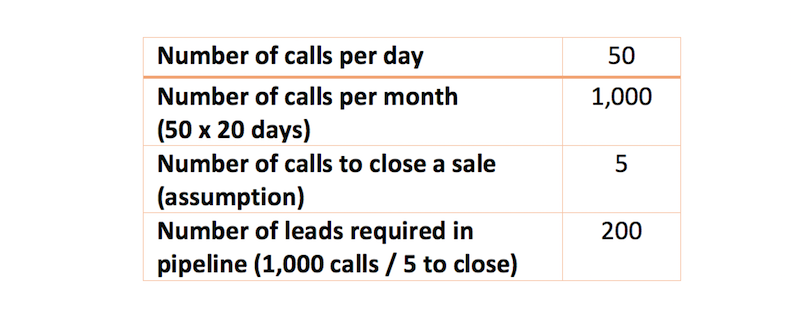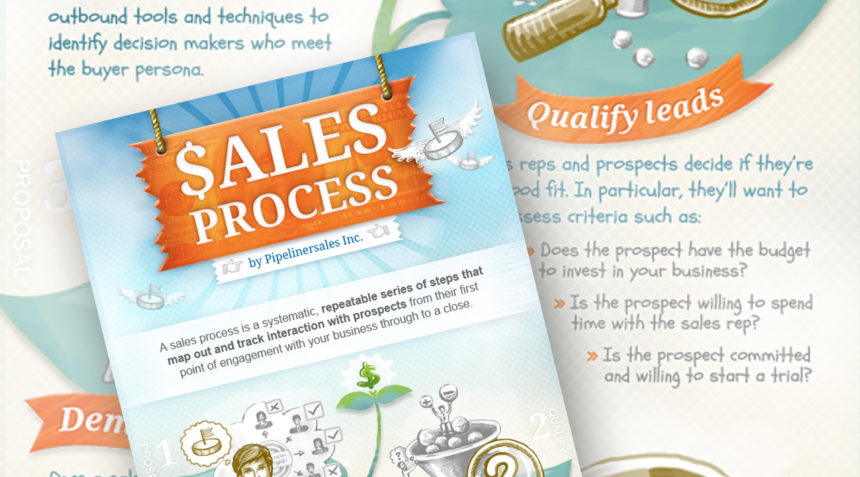10 Questions You Must Ask Yourself When Managing Your Sales Pipeline
We see a lot of articles on sales enablement and progression, but few address the importance of pipeline management and its specific contribution in helping sales teams to step up their game in terms of success and efficiency. So let’s take a look at 10 questions that sales managers should ask themselves about how to effectively manage their sales pipeline, and improve the overall performance of their sales team:
#1: How big should the pipeline be?
Truthfully, the answer really depends on the industry, and how many calls it takes to close a sale. Let’s take a simple example. The workings below are based on an outbound salesperson who does 50 calls a day, taking an average of 5 calls to close a sale. Here, the salesperson needs 200 sales leads in their pipeline.

In my experience, I have managed salespeople with over 2,000 leads in their pipeline. Due to sheer volume, this meant that they never managed these leads effectively and many of them went cold. I’ve also managed salespeople with less than 100 leads in the pipeline, resulting in an inability to hit their targets. By knowing the size of a pipeline, it gives salespeople a much better understanding of how to hit their targets. For a team leader, knowing the size of the pipeline will also help them to manage their team more effectively.
#2: How do I manage the pipeline stages and KPIs?
It’s important to know how every salesperson is progressing along their sales cycle. The first thing to do is create each stage of the pipeline (the number of stages will depend on each company), and understand how the sales process works. KPIs must be assigned to each stage, and only 10% of the salesperson’s overall pipeline should be at the point of ‘the first contact.’ If this number is closer to 50%, then the salesperson is either a new hire, they aren’t making enough calls, or they have an issue getting past the gatekeeper!
Here’s an example of good sales pipeline progression:

And here’s an example of poor progression:

Creating the pipeline stages and setting KPIs will help a sales manager to assess whether their salesperson needs coaching and if they will hit their sales targets that month.
#3: How can I create a sales forecast?
A sales forecast is a projection of revenue as a sales team will look like at the end of each week, month, quarter etc. By using a CRM system, salespeople can keep track of their entire sales process. They can create leads or opportunities that encompass different stages, with each representing a milestone as they work towards winning the customer. In the software world, for example, stages in a pipeline might look like something like this:
- First Contact
- Decision Call
- Demo
- Signed on trial
- Quote
- Closed
Sales leaders can create a basic forecast by multiplying the amount associated to each opportunity by each opportunity’s probability of closing, for those opportunities expected to close this period (i.e. those with a close date set in the CRM system during this period). Here’s an example:

#4: How do I know which sales leads are ready to close?
One of the biggest investments a company can make is for a CRM system. Some CRMs are better than others, but if managed well, salespeople should easily be able to run reports showing the stage life cycle, last contact date, confidence level, and which leads are almost ready to close. For visual competence, ease of onboarding, and sales performance management, Pipeliner CRM ticks the boxes.
The team also needs to look at its sales process and focus on the ‘almost ready to buy’ prospects. They must understand what they need to do to gently move the prospect to the final close stage.
#5: How can I plan my pipeline?
It’s essential to plan a sales pipeline. Failure to plan means less productivity, fewer sales, and less commission. Here are 8 key activities to consider:
- Review any daily tasks scheduled for that day
- Review any sales leads not contacted in the last 72 hours and book them into the calendar to be contacted that day
- Review any ‘hot leads’ on a daily basis which are due to close that week
- Try to book an outbound sales call into the calendar every 15 minutes
- Flag which leads in the pipeline are better to be contacted early in the morning or late in the evening, as not every person can be contacted during working hours
- Update the sales lead/opportunity in the CRM system after every call
- Schedule demos immediately once the call is finished
- Complete a weekly sales forecast
#6: Who should I close first?
Not all customers are the same. Some will be bigger or smaller than others, and some could be very successful brand names that are critical to a company’s success. The leads that should take primary focus are the ones which are ready to close, and the ones critical to company success. It’s also important to note that it may not always be the quick win that should be closed first, as the value of the lead could be very small. Not every customer is worth winning. If a customer’s cost to serve exceeds their value to the business, they shouldn’t be pursued. Some customers will eat up a salesperson’s time after they sign up, causing them to lose out on administration and support that could be spent winning more customers.
#7: Is there too much administration?
New data from the State of Sales Productivity Report by Docurated reveals that:
- Sales reps spend less than one third (32%) of their time selling and pitching prospects
- They spend a near-equal amount of time (31%) searching for sales collateral or creating their own branded content
- Salespeople waste one fifth (20%) of their working hours managing their CRM, tackling administrative tasks and producing reports
Where possible, team leaders should work with salespeople to prepare templates that can be uploaded to the CRM system for everyone to use. This will reduce the amount of time spent by salespeople on creating reports and other content. Sales teams should also work with marketing to prepare product videos that can be easily embedded into sales email templates. Any efforts made to remove administration tasks from a salesperson will reap benefits in closing deals and increasing revenue.
#8: Is the sales team burning leads?
This is a common complaint to sales managers. Typically, salespeople will burn a lead when there’s contact information missing, incorrect contact data, or they have failed to reach the contact after several attempts. In this case, it’s recommended that all ‘close loss’ should be routed automatically through the CRM for the team leader to evaluate whether the sales lead is indeed lost. By reviewing the close lost lead in a timely manner, this can help the sales leader evaluate if the sale person is burning sales leads or closing leads as genuinely the sale cannot be won. This will also help the Sales Manager/ Leader to see if the salesperson needs more coaching on one of the pipeline stage.
#9: Is my CRM system up to date?
If a company is using a CRM system, it’s important that the pipeline is managed in the CRM and not in Excel or on other spreadsheets software. If the pipeline is being updated offline, there’s no way for a sales forecast to be prepared for the team, or evaluate whether a salesperson is burning leads. Consider buying a CRM that has email integration set up to minimize the level of administration needed by the sales team.
#10: How do I avoid pipeline duplication?
Duplication is a serious pain point for all sales teams. Too often, resources are wasted by salespeople calling prospects that have previously been contacted. This can lead to sales forecasts being overstated and customers becoming dissatisfied with mixed messages. The easiest way to resolve duplication is to assign every lead and opportunity a unique identifier, e.g. the website address of the company in a B2B scenario, or the customer’s account number (B2C). By using a unique identifier, the lead/prospect can only be entered once. It may also be a good idea to appoint someone to manage lead generation and enter the sales leads into the CRM system. Either this person or a manager can then allocate the leads to the sales team and avoid any duplication.
Conclusion
Without pipeline management, sales teams are exposed to a litany of problems, such as missing targets, poor sales progression, poor time management, burning leads, and duplication. The best way to manage a sales pipeline is with a CRM system. It’s important to set up the pipeline stages correctly, set KPIs for each stage, create reports, carry out weekly forecasts, and meet with the sales team daily. For any companies currently using spreadsheets, I recommend you start looking for a good CRM. if you’re in B2B selling, consider one that supports both outbound and inbound sales. Managing a pipeline is crucial in leading a sales team to success. A good way to ascertain whether you have a handle on your pipeline is to ask yourself the above 10 questions and see how your answers stack up.









